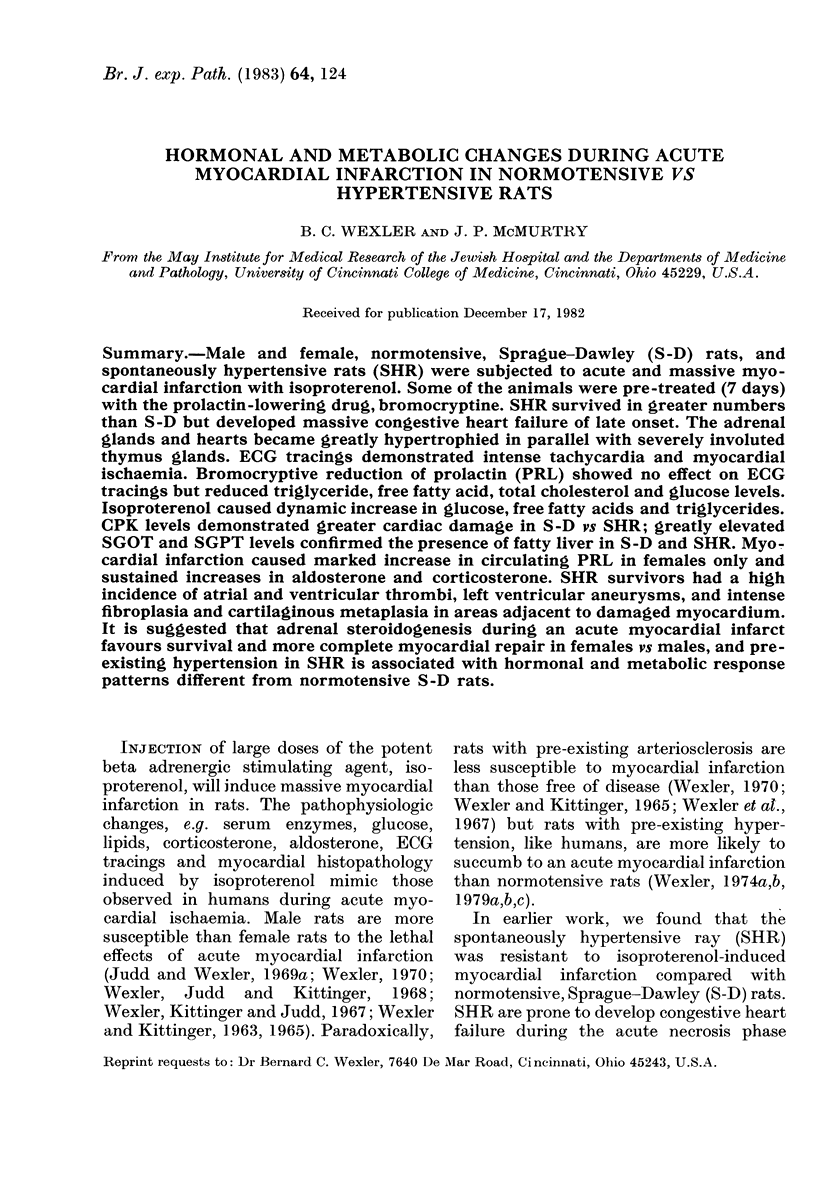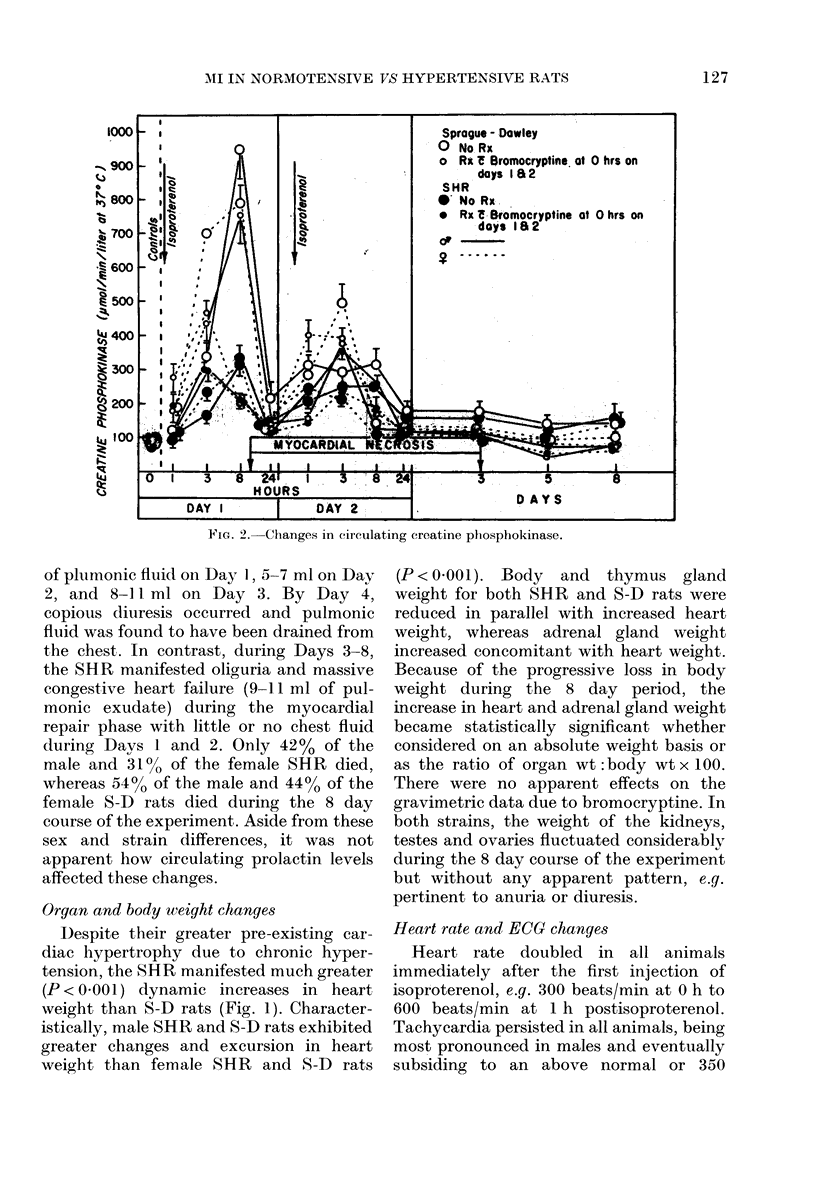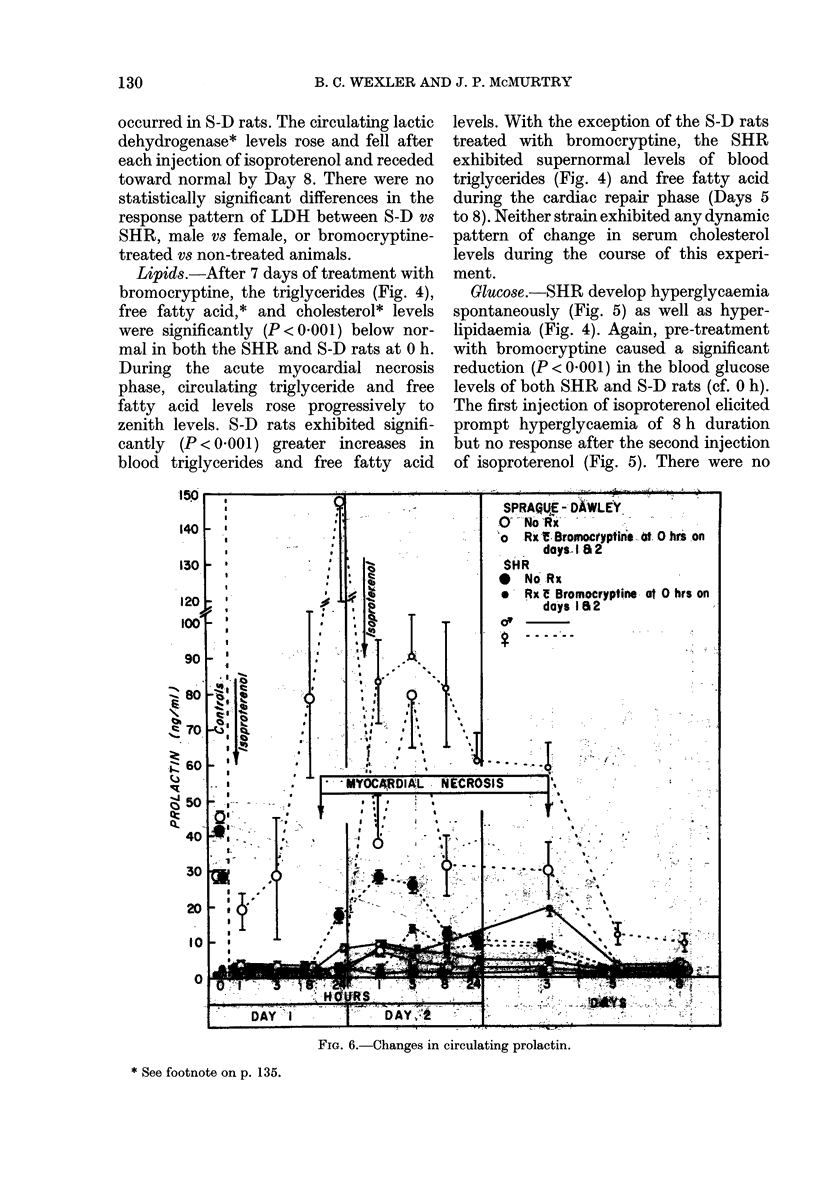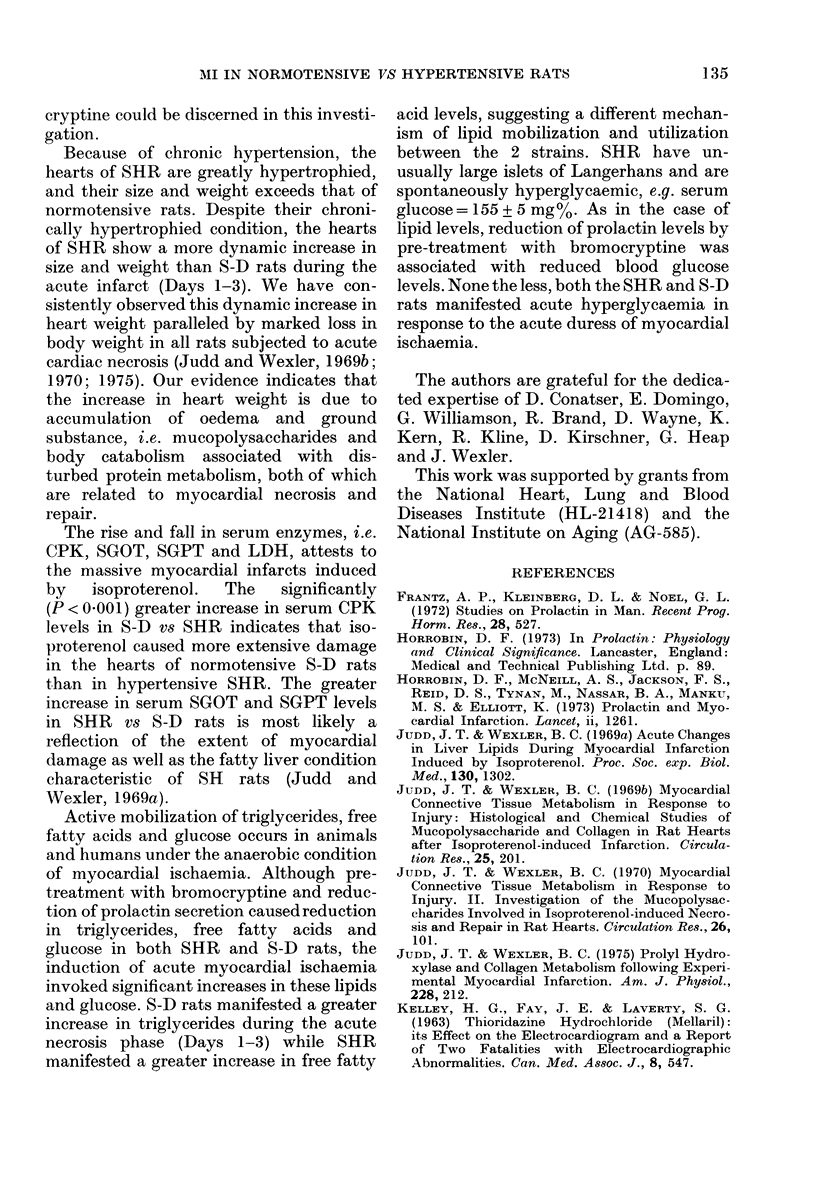Abstract
Male and female, normotensive, Sprague-Dawley (S-D) rats, and spontaneously hypertensive rats (SHR) were subjected to acute and massive myocardial infarction with isoproterenol. Some of the animals were pre-treated (7 days) with the prolactin-lowering drug, bromocryptine. SHR survived in greater numbers than S-D but developed massive congestive heart failure of late onset. The adrenal glands and hearts became greatly hypertrophied in parallel with severely involuted thymus glands. ECG tracings demonstrated intense tachycardia and myocardial ischaemia. Bromocryptine reduction of prolactin (PRL) showed no effect on ECG tracings but reduced triglyceride, free fatty acid, total cholesterol and glucose levels. Isoproterenol caused dynamic increase in glucose, free fatty acids and triglycerides. CPK levels demonstrated greater cardiac damage in S-D vs SHR; greatly elevated SGOT and SGPT levels confirmed the presence of fatty liver in S-D and SHR. Myocardial infarction caused marked increase in circulating PRL in females only and sustained increases in aldosterone and corticosterone. SHR survivors had a high incidence of atrial and ventricular thrombi, left ventricular aneurysms, and intense fibroplasia and cartilaginous metaplasia in areas adjacent to damaged myocardium. It is suggested that adrenal steroidogenesis during an acute myocardial infarct favours survival and more complete myocardial repair in females vs males, and preexisting hypertension in SHR is associated with hormonal and metabolic response patterns different from normotensive S-D rats.
Full text
PDF












Images in this article
Selected References
These references are in PubMed. This may not be the complete list of references from this article.
- Frantz A. G., Kleinberg D. L., Noel G. L. Studies on prolactin in man. Recent Prog Horm Res. 1972;28:527–590. [PubMed] [Google Scholar]
- Horrobin D. F., McNeilly A. S., Jackson F. S., Reid D. S., Tynan M., Nassar B. A., Manku M. S., Elliott K. Letter: Prolactin and myocardial infarction. Lancet. 1973 Dec 1;2(7840):1261–1261. doi: 10.1016/s0140-6736(73)90997-5. [DOI] [PubMed] [Google Scholar]
- Judd J. T., Wexler B. C. Acute changes in liver lipids during myocardial infarction induced by isoproterenol. Proc Soc Exp Biol Med. 1969 Apr;130(4):1302–1305. doi: 10.3181/00379727-130-33778. [DOI] [PubMed] [Google Scholar]
- Judd J. T., Wexler B. C. Myocardial connective tissue metabolism in response to injury. Histological and chemical studies of mucopolysaccharide and collagen in rat hearts after isoproterenol-induced infaraction. Circ Res. 1969 Aug;25(2):201–214. doi: 10.1161/01.res.25.2.201. [DOI] [PubMed] [Google Scholar]
- Judd J. T., Wexler B. C. Myocardial connective tissue metabolism in response to injury. II. Investigation of the mucopolysaccharides involved in isoproterenol-induced necrosis and repair in rat hearts. Circ Res. 1970 Jan;26(1):101–109. doi: 10.1161/01.res.26.1.101. [DOI] [PubMed] [Google Scholar]
- Judd J. T., Wexler B. C. Prolyl hydroxylase and collagen metabolism after experimental mycardial infarction. Am J Physiol. 1975 Jan;228(1):212–216. doi: 10.1152/ajplegacy.1975.228.1.212. [DOI] [PubMed] [Google Scholar]
- Lewis B. K., Wexler B. C. Serum prolactin levels in rats following isoproterenol-induced myocardial infarction. Proc Soc Exp Biol Med. 1975 Dec;150(3):712–717. doi: 10.3181/00379727-150-39112. [DOI] [PubMed] [Google Scholar]
- McKenzie J. K., Clements J. A. Simplified radioimmunoassay for serum aldosterone utilizing increased antibody specificity. J Clin Endocrinol Metab. 1974 Apr;38(4):622–627. doi: 10.1210/jcem-38-4-622. [DOI] [PubMed] [Google Scholar]
- McMurtry J. P., Kazama N., Wexler B. C. Effects of bromocryptine on hormone and blood pressure levels in the spontaneously hypertensive rat. Proc Soc Exp Biol Med. 1979 Jun;161(2):186–188. doi: 10.3181/00379727-161-40517. [DOI] [PubMed] [Google Scholar]
- McMurtry J. P., Malven P. V. Radioimmunoassay of endogenous and exogenous prolactin in milk of rats. J Endocrinol. 1974 May;61(2):211–217. doi: 10.1677/joe.0.0610211. [DOI] [PubMed] [Google Scholar]
- McMurtry J. P., Wexler B. C. Hypersensitivity of spontaneously hypertensive rats (SHR) to heat, ether, and immobilization. Endocrinology. 1981 May;108(5):1730–1736. doi: 10.1210/endo-108-5-1730. [DOI] [PubMed] [Google Scholar]
- Murphy B. E. Some studies of the protein-binding of steroids and their application to the routine micro and ultramicro measurement of various steroids in body fluids by competitive protein-binding radioassay. J Clin Endocrinol Metab. 1967 Jul;27(7):973–990. doi: 10.1210/jcem-27-7-973. [DOI] [PubMed] [Google Scholar]
- Sowers J. R., Resch G., Tempel G., Herzog J., Colantino M. Hyperprolactinaemia in the spontaneously hypertensive rat. Acta Endocrinol (Copenh) 1979 Jan;90(1):1–7. doi: 10.1530/acta.0.0900001. [DOI] [PubMed] [Google Scholar]
- Stumpe K. O., Kolloch R., Higuchi M., Krück F., Vetter H. Hyperprolactinaemia and antihypertensive effect of bromocriptine in essential hypertension. Identification of abnormal central dopamine control. Lancet. 1977 Jul 30;2(8031):211–214. doi: 10.1016/s0140-6736(77)92832-x. [DOI] [PubMed] [Google Scholar]
- WEXLER B. C., KITTINGER G. W. STEROIDS PRODUCED IN VITRO BY ADRENAL GLANDS OF NORMAL AND ARTERIOSCLEROTIC RATS DURING AND AFTER DRUG-INDUCED MYOCARDIAL NECROSIS. Circ Res. 1965 Apr;16:322–331. doi: 10.1161/01.res.16.4.322. [DOI] [PubMed] [Google Scholar]
- Wexler B. C. Adrenocortical changes associated with methylandrostenediol-induced hypertension and isoproterenol-induced myocardial infarction in arteriosclerotic versus nonarteriosclerotic rats. Lab Invest. 1974 Mar;30(3):251–259. [PubMed] [Google Scholar]
- Wexler B. C. Isoprenaline-induced myocardial infarction in spontaneously hypertensive rats. Cardiovasc Res. 1979 Aug;13(8):450–458. doi: 10.1093/cvr/13.8.450. [DOI] [PubMed] [Google Scholar]
- Wexler B. C., Judd J. T., Kittinger G. W. Myocardial necrosis induced by isoproterenol in rats. Changes in serum protein, lipoprotein, lipids and glucose during active necrosis and repair in arteriosclerotic and nonarteriosclerotic animals. Angiology. 1968 Dec;19(11):665–682. doi: 10.1177/000331976801901103. [DOI] [PubMed] [Google Scholar]
- Wexler B. C., Kittinger G. W., Judd J. T. Responses to drug-induced myocardial necrosis in rats with various degrees of arteriosclerosis. Circ Res. 1967 Jan;20(1):78–87. doi: 10.1161/01.res.20.1.78. [DOI] [PubMed] [Google Scholar]
- Wexler B. C. Myocardial infarction in spontaneously hypertensive rats with superimposed adrenal-regeneration hypertension. Br J Exp Pathol. 1979 Aug;60(4):366–381. [PMC free article] [PubMed] [Google Scholar]
- Wexler B. C. Opposing effects of deoxycorticosterone and spironolactone on isoprenaline-induced myocardial infarction. Cardiovasc Res. 1979 Feb;13(2):119–126. doi: 10.1093/cvr/13.2.119. [DOI] [PubMed] [Google Scholar]
- Wexler B. C. Pathophysiologic effects of pre-existing hypertension on isoproterenol-induced myocardial infarction in arteriosclerotic and non-arteriosclerotic rats. Atherosclerosis. 1974 Mar-Apr;19(2):161–184. doi: 10.1016/0021-9150(74)90052-5. [DOI] [PubMed] [Google Scholar]
- Wexler B. C. Serum creatine phosphokinase activity following isoproterenol-induced myocardial infarction in male and female rats with and without arteriosclerosis. Am Heart J. 1970 Jan;79(1):69–79. doi: 10.1016/0002-8703(70)90395-9. [DOI] [PubMed] [Google Scholar]




